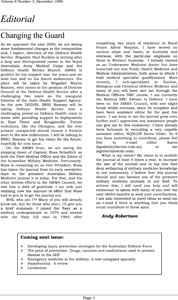BATTLEFIELD LEGACIES: THE AUSTRALIAN COLLECTION OF WWI PATHOLOGICAL SPECIMENS
Hearder R. Battlefield legacies: The Australian collection of WW1 pathological specimens. Aust Mil Med 1999;. Rosalind Hearder BA (Hons) is a military medical historian who is currently doing her PhD in history at the University of Melbourne. There no longer seems to exist any documentation that records the name or nationality of patients from whom… Read more »




 Download the whole edition here.
Download the whole edition here.


